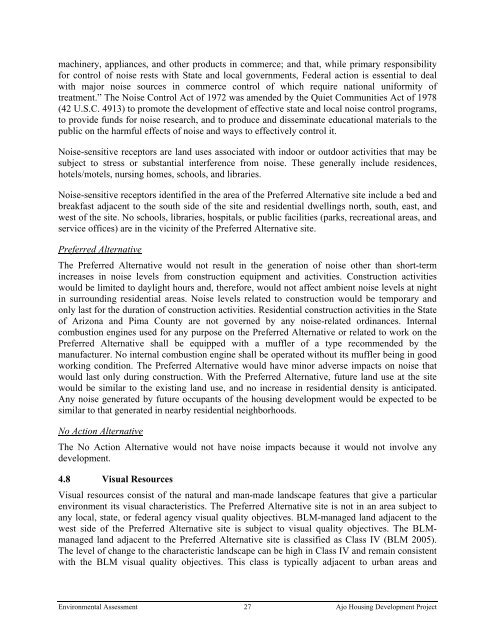US Customs and Border Protection Ajo Housing Development ... - GSA
US Customs and Border Protection Ajo Housing Development ... - GSA
US Customs and Border Protection Ajo Housing Development ... - GSA
Create successful ePaper yourself
Turn your PDF publications into a flip-book with our unique Google optimized e-Paper software.
machinery, appliances, <strong>and</strong> other products in commerce; <strong>and</strong> that, while primary responsibility<br />
for control of noise rests with State <strong>and</strong> local governments, Federal action is essential to deal<br />
with major noise sources in commerce control of which require national uniformity of<br />
treatment.” The Noise Control Act of 1972 was amended by the Quiet Communities Act of 1978<br />
(42 U.S.C. 4913) to promote the development of effective state <strong>and</strong> local noise control programs,<br />
to provide funds for noise research, <strong>and</strong> to produce <strong>and</strong> disseminate educational materials to the<br />
public on the harmful effects of noise <strong>and</strong> ways to effectively control it.<br />
Noise-sensitive receptors are l<strong>and</strong> uses associated with indoor or outdoor activities that may be<br />
subject to stress or substantial interference from noise. These generally include residences,<br />
hotels/motels, nursing homes, schools, <strong>and</strong> libraries.<br />
Noise-sensitive receptors identified in the area of the Preferred Alternative site include a bed <strong>and</strong><br />
breakfast adjacent to the south side of the site <strong>and</strong> residential dwellings north, south, east, <strong>and</strong><br />
west of the site. No schools, libraries, hospitals, or public facilities (parks, recreational areas, <strong>and</strong><br />
service offices) are in the vicinity of the Preferred Alternative site.<br />
Preferred Alternative<br />
The Preferred Alternative would not result in the generation of noise other than short-term<br />
increases in noise levels from construction equipment <strong>and</strong> activities. Construction activities<br />
would be limited to daylight hours <strong>and</strong>, therefore, would not affect ambient noise levels at night<br />
in surrounding residential areas. Noise levels related to construction would be temporary <strong>and</strong><br />
only last for the duration of construction activities. Residential construction activities in the State<br />
of Arizona <strong>and</strong> Pima County are not governed by any noise-related ordinances. Internal<br />
combustion engines used for any purpose on the Preferred Alternative or related to work on the<br />
Preferred Alternative shall be equipped with a muffler of a type recommended by the<br />
manufacturer. No internal combustion engine shall be operated without its muffler being in good<br />
working condition. The Preferred Alternative would have minor adverse impacts on noise that<br />
would last only during construction. With the Preferred Alternative, future l<strong>and</strong> use at the site<br />
would be similar to the existing l<strong>and</strong> use, <strong>and</strong> no increase in residential density is anticipated.<br />
Any noise generated by future occupants of the housing development would be expected to be<br />
similar to that generated in nearby residential neighborhoods.<br />
No Action Alternative<br />
The No Action Alternative would not have noise impacts because it would not involve any<br />
development.<br />
4.8 Visual Resources<br />
Visual resources consist of the natural <strong>and</strong> man-made l<strong>and</strong>scape features that give a particular<br />
environment its visual characteristics. The Preferred Alternative site is not in an area subject to<br />
any local, state, or federal agency visual quality objectives. BLM-managed l<strong>and</strong> adjacent to the<br />
west side of the Preferred Alternative site is subject to visual quality objectives. The BLMmanaged<br />
l<strong>and</strong> adjacent to the Preferred Alternative site is classified as Class IV (BLM 2005).<br />
The level of change to the characteristic l<strong>and</strong>scape can be high in Class IV <strong>and</strong> remain consistent<br />
with the BLM visual quality objectives. This class is typically adjacent to urban areas <strong>and</strong><br />
Environmental Assessment 27 <strong>Ajo</strong> <strong>Housing</strong> <strong>Development</strong> Project
















